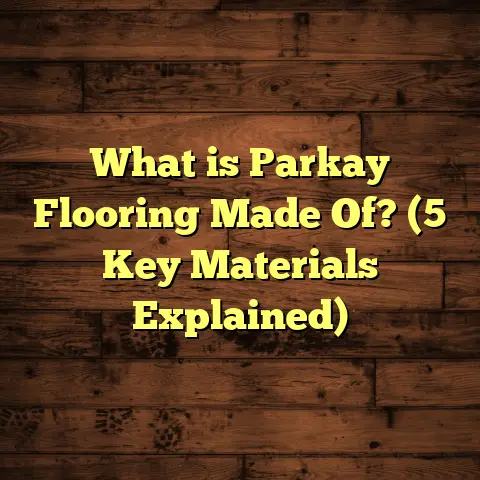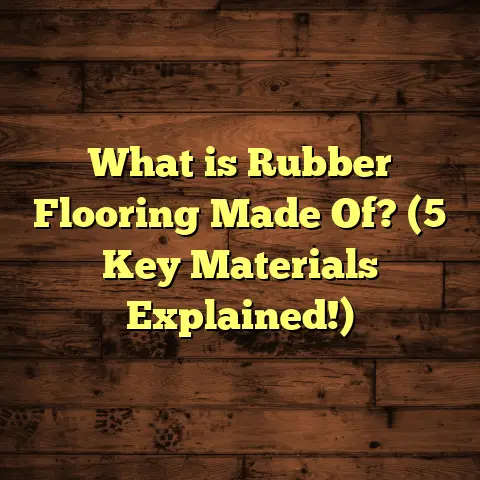What is Parquet Wood Flooring? (5 Benefits & Design Tips)
Investing in your home’s flooring is more than just picking something that looks good; it’s a decision that impacts your daily living experience, maintenance effort, and even property value for years to come. When I first considered parquet wood flooring for my own home and several client projects, I saw it as an opportunity to combine classic elegance with practical benefits. It wasn’t just about having a pretty floor—it was about choosing a solution that offers durability, timeless style, and unique character.
Over the years, I’ve learned a lot about parquet flooring—from how it’s made and installed to how you care for it and why it can be a smart investment. Let me walk you through everything I know about this beautiful flooring option, sharing my personal experiences, data-backed insights, and useful tips you can apply whether you’re thinking about renovating a small room or outfitting an entire house.
What is Parquet Wood Flooring?
Parquet wood flooring is a type of flooring made from small pieces of hardwood, arranged in geometric and often decorative patterns. Unlike traditional hardwood floors that use long planks laid in straight lines, parquet involves assembling wood blocks or strips into artistic designs such as herringbone, chevron, basket weave, or even intricate mosaics.
The word “parquet” comes from the French term for “small enclosed space,” referring to the individual pieces of wood fitted together like a puzzle. The beauty lies not only in the wood itself but in how these pieces interact visually to form patterns that add texture and dimension to the surface.
Types of Parquet Flooring
Parquet floors come mainly in two types: solid wood parquet and engineered parquet.
- Solid wood parquet: Each tile consists of solid hardwood pieces glued together. These require a sturdy subfloor and are often nailed or glued down during installation. They can be sanded and refinished multiple times over their lifespan.
- Engineered parquet: These tiles have a thin layer of hardwood on top of plywood or high-density fiberboard (HDF). Engineered parquet is more resistant to moisture changes and can often be installed as a floating floor.
In my experience, engineered parquet works well in areas prone to humidity fluctuations like basements or kitchens, while solid wood parquet fits perfectly in living rooms or formal dining spaces where classic appeal shines.
Common Wood Species Used
The choice of wood species affects not only appearance but durability and maintenance. Here are some popular options I’ve used:
| Wood Species | Janka Hardness (lbf) | Appearance Characteristics | Durability |
|---|---|---|---|
| Oak | 1,290 | Light to medium brown with grain | Strong, widely used |
| Walnut | 1,010 | Rich dark brown with deep grain | Durable but softer |
| Maple | 1,450 | Light cream color, fine grain | Very hard, smooth |
| Cherry | 950 | Reddish-brown that darkens over time | Softer, ages well |
The Janka hardness rating indicates resistance to denting and wear. In my projects, I tend to recommend oak or maple for high-traffic areas due to their superior hardness.
The Beauty and Practicality Behind Parquet Flooring
When I first installed parquet in my own home’s living room, I noticed how it instantly added warmth and sophistication. The patterns catch the eye without overwhelming the space. But beyond aesthetics, parquet has several practical advantages worth highlighting.
1. Timeless Elegance with Endless Design Options
Parquet floors have been favored since the 1600s in European palaces and grand homes—and the trend continues today. Their ability to suit both traditional and contemporary interiors is remarkable. For example, a classic herringbone pattern creates a sense of movement and flow, while basket weave lends a handcrafted feel.
I remember one client who wanted a modern twist on tradition. We chose engineerd walnut parquet tiles arranged in a subtle chevron pattern with a matte finish. The result was an elegant floor that didn’t compete with bold furnishings but complemented them beautifully.
2. Durability That Meets Everyday Demands
Hardwood species used in parquet are naturally durable. To put it into perspective with real numbers: according to the Janka scale (which measures wood’s resistance to denting), oak scores around 1,290 lbf—meaning it can withstand substantial pressure before denting.
In busy households where pets and kids run around, this durability matters. Parquet’s small pieces also distribute stress more evenly than large planks, which can reduce cracking or warping over time. I’ve seen parquet floors last for decades when properly maintained.
3. Boosting Home Value with Character
One of the most satisfying parts of my work is seeing how new floors increase a home’s market appeal. Wood floors in general add value; reports show hardwood can recoup approximately 70% of installation costs at resale.
Parquet flooring takes this further because its unique patterns signal craftsmanship and attention to detail—qualities buyers appreciate. Data from real estate studies indicate homes with distinctive hardwood floors often sell faster and at higher prices than those with standard flooring options.
4. Repairability and Longevity
Unlike vinyl or laminate floors that must be replaced once damaged, parquet floors can often be repaired by replacing individual tiles. This patchwork fix is cost-effective compared to replacing entire sections.
I’ve personally refinished parquet floors multiple times on older homes—sanding down surface scratches and reapplying finish brought them back to life each time. This extends the life of your investment significantly.
5. Cleaner Indoor Air Quality
For families sensitive to allergens, parquet offers an advantage over carpets that trap dust mites and pet dander. Wood floors don’t harbor allergens as much and are easy to keep clean with regular sweeping and mopping.
In fact, I’ve had clients with asthma who noticed improvement once they switched from carpeted bedrooms to parquet wood flooring.
Installation: What You Need to Know
Installing parquet isn’t exactly like laying down regular hardwood planks—it requires precision and preparation to get the best results.
Preparing the Subfloor
Before installation begins, ensuring the subfloor is level, dry, and clean is crucial. Uneven surfaces can cause tiles to shift or crack over time. In one project where the subfloor wasn’t properly leveled beforehand, we had to redo parts of the installation after noticing some tiles loosening within months.
Installation Methods
- Glue-down installation: This involves spreading adhesive on the subfloor before placing each parquet tile directly onto it. It provides strong bonding but requires drying time afterward.
- Floating installation: The tiles lock together over an underlayment without glue. This method is faster but may feel less solid underfoot.
Glue-down is preferable for high-traffic areas or where maximum stability is desired. Floating methods work well in DIY settings or when installing over radiant heat systems.
Timeframe
Professional installers typically take between 3–5 days for an average-sized room (about 300–500 sq ft), including preparation and finishing.
Do-It-Yourself Considerations
I once tried floating installation for a small study room myself. It was doable but demanded careful measuring, cutting small pieces precisely, and patience to maintain consistent patterns throughout.
If you’re handy with tools, floating parquet installation can be manageable—but if you want flawless results without stress, hiring experienced installers is wise.
Caring for Your Parquet Floor
Proper maintenance keeps parquet looking beautiful for decades. Here’s what I’ve learned through years of working with these floors:
Daily Care
- Sweep or vacuum regularly to remove grit that can scratch the surface.
- Use soft-bristle brooms or vacuum attachments designed for wood floors.
- Wipe up spills immediately to prevent moisture damage.
Cleaning Products
Avoid harsh chemicals or abrasive cleaners that degrade finish layers. I recommend pH-neutral cleaners made specifically for hardwood floors—these keep the surface shiny without stripping oils.
Preventing Damage
Furniture pads under legs prevent scratching; area rugs help protect high-traffic zones; avoid walking on the floor with heels or cleats.
Refinishing Schedule
Depending on wear levels, refinishing every 7–10 years restores vibrancy. With solid wood parquet especially, sanding removes surface imperfections while preserving tile integrity.
Real Numbers: Cost Breakdown & Budgeting Tips
When planning any flooring project, cost is always top of mind. Parquet tends to be more expensive than standard hardwood planks due to its labor-intensive installation and pattern complexity.
Here’s what I’ve observed from multiple projects:
| Cost Component | Estimated Price Range (per sq ft) | Notes |
|---|---|---|
| Materials | $8 – $15 | Depends on wood species & quality |
| Installation Labor | $6 – $12 | Glue-down is more expensive than floating |
| Finishing (staining/sealing) | $1 – $3 | Optional depending on finish chosen |
| Total Average Cost | $15 – $30 | Higher-end materials & complex patterns raise cost |
To avoid surprises during budgeting, I rely on FloorTally—a tool that helps me input local labor rates and material prices for precise estimates catered to each project’s specifics. It even calculates waste factors based on pattern types (herringbone generates more scrap than straight plank layouts).
Using FloorTally has saved me from underquoting jobs or running into unexpected expenses midway through installation.
Design Ideas That Make Parquet Pop
Want your floor to be a conversation starter? Here are some design tips I’ve used successfully:
Scale Your Pattern Right
Big rooms handle bold patterns like oversized chevron well; smaller rooms benefit from subtle herringbone or small block patterns that don’t overwhelm the space visually.
Wood Species + Finish Combo
Lighter woods with natural finishes brighten rooms; darker woods with matte finishes add coziness without looking dated.
Mix Wood Tones for Depth
Combining contrasting shades within parquet patterns adds richness—think light oak blocks paired with deeper walnut accents.
Pair Parquet with Other Flooring Materials
I’ve installed parquet as a centerpiece surrounded by tile borders or adjacent to carpeted areas—this zoning technique defines spaces in open floor plans beautifully.
Consider Underfloor Heating Options
Engineered parquet works well over radiant heat systems if installed per manufacturer guidelines—perfect for cold climates needing cozy floors!
A Real-Life Project Story: Bringing Walnut Parquet Back to Life
One memorable project was restoring a 1920s bungalow where original hardwood was beyond repair. The homeowners wanted something authentic yet durable.
We selected walnut parquet tiles arranged in a classic herringbone pattern—the rich warm tones matched period furnishings perfectly.
After meticulous subfloor prep and professional glue-down installation, we sealed the floor with a low-VOC matte finish for environmental friendliness.
Over the next year, despite active family life with kids and pets, the floor showed minimal wear—just minor surface scratches easily buffed out during annual maintenance visits.
This project showed me again how parquet bridges history and modern living effortlessly.
Common Questions I Hear About Parquet Flooring
Is Parquet Flooring Suitable for Kitchens or Bathrooms?
While parquet adds warmth to kitchens, moisture exposure makes it less ideal for bathrooms unless well-sealed engineered wood is used with proper ventilation.
How Does Parquet Compare to Regular Hardwood Floors?
Parquet offers more visual interest due to its patterns but typically costs more due to installation complexity. It also distributes wear differently because of smaller wood pieces joined together.
Can I Install Parquet Over Existing Flooring?
Generally no—parquet requires a stable subfloor without flex or unevenness. Removal of old flooring is recommended before installation for best results.
How Long Does Parquet Flooring Last?
With proper care and periodic refinishing every decade or so, parquet floors can last 50+ years—sometimes even longer in historic homes.
What Are Some Patterns I Can Choose?
Popular designs include herringbone (zigzag), chevron (V shapes), basket weave (blocks woven together), Versailles (intricate mosaics), among others.
Final Thoughts on Parquet Wood Flooring
Choosing flooring is a big decision packed with practical and aesthetic considerations. From my perspective as someone who’s installed many types of floors over the years—and personally lives with parquet—I can say this option offers an unmatched blend of durability, style flexibility, and lasting value.
If you want your floors to tell a story through craftsmanship while standing up to modern living demands, parquet wood flooring deserves serious thought.
Have you thought about trying parquet? Or maybe you already have questions about patterns or installation? Don’t hesitate to ask—I’m here to share everything I’ve learned along the way!





